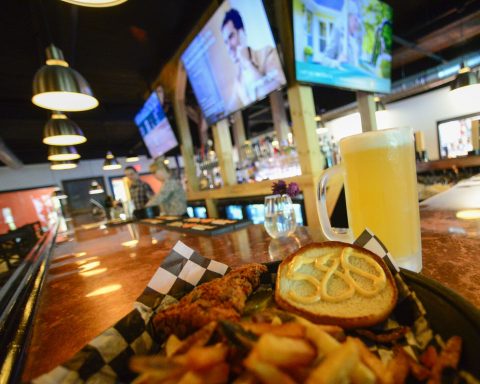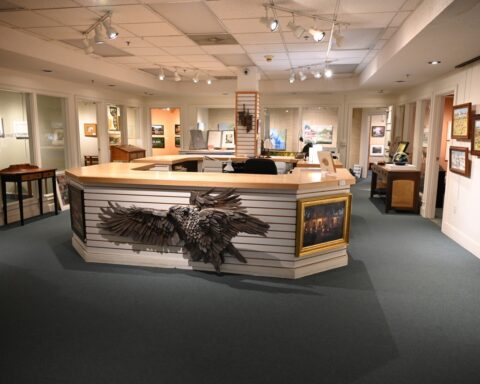By Gordon Dossett, Vermont Country Magazine.
MANCHESTER — Do we locals ever act as tourists at home? A tourist dives into some of the best spots of a place, eager to experience what it has to offer. Too often, I settle into a routine and skip the places tourists travel hours to seek out. I decided to be a tourist in the Northshire, and see what I was missing. This is a part of an occasional series.
Centuries-old falconry, with its elaborate dance between bird and human, has inspired poetry. Yeats, in decrying the decline of civilization, writes that the “falcon cannot hear the falconer”: the subtle communication between people and the natural world has broken down.

Fortunately, that is not the case at Green Mountain Falconry School in Manchester where falconry flourishes. Rob Waite, from Buckinghamshire in the south of England, with his cast of hawks carries on the tradition at the beautiful 50-acre Boorn Brook Farm. From May through late October he gives visitors a glimpse into the lives of “birds of the fist.”
The school Waite operates is not one of desks, exams and diplomas, but simply of learning: he’s offering experiential education — walks with hawks. And the name “falconry” is by Waite’s definition, “hunting with a trained bird of prey.” Birds of prey come from certain families, including falcons, owls, osprey, kites, vultures. But as Waite says, “we’re not really interested in flying owls and vultures.” Falconry need not imply falcons. Instead, for their temperament, he’s chosen hawks — Harris’s hawks, specifically, native to the scrub brush of Arizona. Hawks are trained to come to meat displayed on a gloved fist; falcons, in contrast, chase meat on a string.

In Waite’s casual explanation, training hawks might seem simple.
“You can go from a completely untrained bird — one that won’t stand on your hand, he’s so terrified — to trained in about a week and a half. They learn fast, because if in the wild they don’t, they die.”
Rob Waite
Start to hear the details of the training, and you realize the expertise and patience that go into this week and a half. The first part, called “manning,” occurs where there will be no disturbance. Waite uses his basement. Because hawks are nervous, Waite starts by sitting quietly with the bird in a darkened room, traditionally by candlelight. (Hawks feel at ease in the dark, by instinct perceiving little threat.) Waite spends hours and hours over the first few days, time spent tied to how quickly the hawk settles down. The falconer gradually increases the light and makes slow, steady movements as the hawk shows signs of tolerating the situation.
“The next step,” Waite explains, “is to get the hawk to take food from the gloved hand it is sitting on. This shows it is relaxing a little and is a huge step because … the falconer [can] begin to use the positive reinforcement … crucial to training.” Depending upon the individual and the species being trained, feeding off the fist for the first time usually takes several days. “A bird may come back to you over 5 feet, but it doesn’t at 7 feet. The next day it comes back 12 feet but not 15.” Waite makes small adjustments, and eventually introduces the lure, which simulates a mouse or rat.
From here, Waite walks around with the hawk, and then gradually trains the hawk to return to the fist, employing a “creance” (a training line that limits the bird’s flying distance).
Hawks need special training for hunts that also use dogs to flush out pheasants and grouse. Harris’s hawks need to be trained to overcome their inbred fear of dogs, coyotes being one of the hawks’ predators.
The falconer’s training of the hawk sets up very specific expectations. For example, the hawk flies in to take the meat only over the back of the hand — and only a gloved hand, the leather a particular color and only the left hand (unless otherwise trained). As Waite explains, “If you raise the bare hand, he’s never been fed from a bare hand, so why come in?” The hawk will remain perched in the tree.
Waite demystifies the idea of flying itself. “The bird is a working animal. Whatever you see it doing, it’s getting something out of the deal.” Even though humans might see flying as fun, birds fly to hunt. If the hawks aren’t hungry or if they see no prey, “they’ll sit in the tree and save energy.”

Waite maintains a chalkboard listing “flying weight” and “today’s weight” for each of his six birds. “If they go just half an ounce over their target weight, that’s enough for me to really question whether I want to risk flying the bird,” Waite says. Being full, a bird is less inclined to come back.
Birds don’t “escape,” that is not an intentional act; a bird and falconer can become “separated.” “I chased one bird for 24 hours on up and down hills of Green Mountains,” says Waite, and one bird was gone for six months, returning in good shape.
Once a hawk is brought to an open field, ringed by brush and trees, he or she (females are bigger) scouts for food, even grubs in the grass. “Grubs are like french fries for birds,” Waite says as Elmer pecks at the ground. A Harris’s hawk can see a mouse at a quarter mile, a rabbit at a mile.
Next comes an elemental moment, one that will thrill your blood: having a hawk dive at you, pouncing on food.

“Brute beauty and valour and act,” says poet Gerald Manly Hopkins of a falcon in flight, “oh, air, pride, plume, here/Buckle.” Hold out your gloved left arm, hand made into a fist, and the hawk swooshes in, fluttering down from height. In a flurry, Waite is putting meat in your fist, and the hawk is spreading its wings to land, its beak snatching the meat, its talons softly settling on the glove.
In that wedge of time, you feel the “brute beauty and valour” of the natural world, in strange harmony with us humans.
As your heart settles, you hear Waite talking about excursions with various hawks. Once, on returning from a long hike with two birds, a visitor said, “‘they didn’t catch anything.’ And Monty streaked across the lawn, went into the brush, grabbed a mouse and ate it. Two days before that, Bailey chased a duck.”
Waite explains how traditional falconry meant survival.

“That hawk that caught that duck; you want to eat the duck,” so the hunter gets there and takes the duck from the hawk, and then keeps hunting, because the hawk is still hungry. And at the end of the day, you might return home with enough to feed your family and the hawk.
Even today, Waite says, “we don’t waste the kill.” If a hawk catches a grouse or rabbit, the hunter might choose to eat it or might choose to feed it to the hawk. “The mice — they’re welcome to,” Waite adds with a laugh.

Because using guns to hunt became more practical, falconry faded out over the centuries. Waite says that his own first kill with a hawk came only after a year of hunting, and the hawk caught a rat. Unlike eagles with 6-foot wingspans, Harris’s hawks are used to hunting close wooded or brushy areas. Such habitat is tough. Harris’s hawks live five to six years in the wild, perishing from lack of prey or minor injuries that hurt their hunting; 70 percent of birds in the wild die in their first year. Waite’s birds, in contrast, have lived into their early 30s; Elmer, for example, is 27. In Vermont’s frigid winters, they are housed in heated barns.
A visit to Rob Waite’s Green Mountain Falconry School is a step back in time, when people and hawks eked out an existence in tandem. It’s also a step into a hopeful future, where animals, people and the environment can live in harmony.
Visits to Green Mountain Falconry School by appointment only. Visit greenmountainfalconryschool.com or email: greenmountainfalconry@comcast.net.

Gordon Dossett traded the traffic and urban ugliness of Los Angeles for the Green Mountains. He lives with his teenaged children, a cat and a dog, packing urban sprawl into one home. He likes making to-do lists and losing them.












